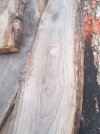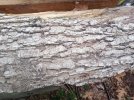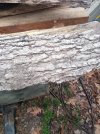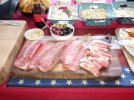-
The BladeForums.com 2024 Traditional Knife is available! Price is $250 ea (shipped within CONUS).
Order here: https://www.bladeforums.com/help/2024-traditional/
You are using an out of date browser. It may not display this or other websites correctly.
You should upgrade or use an alternative browser.
You should upgrade or use an alternative browser.
What’s this wood?
- Thread starter DanF
- Start date
- Joined
- Dec 27, 2013
- Messages
- 2,679
I try to talk about wood at parties and just get weird looks.Ooops to me - Thank you DanF for pointing it, and a BIG Thank you to Ben for the info. Ben sure is a fount of knowledge and is so willing to share with rest of us.
You guys are the only ones willing to let me ramble about how curly figure is a type of transverse figure and so shows on quartersawn faces and quilted figure is a longitudinal figure and only appears on flatsawn faces.
Stacy E. Apelt - Bladesmith
ilmarinen - MODERATOR
Moderator
Knifemaker / Craftsman / Service Provider
- Joined
- Aug 20, 2004
- Messages
- 38,271
OK, Ben, lets chat about this wood.
I got four 6-foot natural edge slabs and the outside cut piece from a clean-out job with a friend after an eviction. The former resident had woodworking tools galore as well as a full jeweler's setup. I got most of the tools and jewelers' stuff for helping with gutting out the place. The fellow made tables and cutting boards. The wood is very weathered and darkened with age but when sanded out is amazing. There are bug holes and some old termite tunnels in the wood, which gives it lots of character. The slabs are lighter weight than they look, but the big outside cut is heavy, probably 60-70 pounds. The face side of the outside cut looks like the other slabs. My guess is that it sat as a downed tree for a long time before harvesting. My first thought was that it is oak.
I made a charcuterie board (in the photo) out of a smaller piece, and likely will make use rest of the slabs for more of the same. The only finish on the wood is butcher's oil and conditioner.
The big outside cut I will run through the thickness sander and flatten the bark side back enough to make a table out of the piece. I will use the bottom of an old foot treadle sewing machine as the base.
I'll take some closer shots later today and some more after I run it through the sander. I'll start a new thread after I get it cleaned up.
You can also see in the photos some big pieces of mantle size wood that the fellow had sanded out and covered with resin to fill the cracks. I'm not sure they are from the same tree or not.




I got four 6-foot natural edge slabs and the outside cut piece from a clean-out job with a friend after an eviction. The former resident had woodworking tools galore as well as a full jeweler's setup. I got most of the tools and jewelers' stuff for helping with gutting out the place. The fellow made tables and cutting boards. The wood is very weathered and darkened with age but when sanded out is amazing. There are bug holes and some old termite tunnels in the wood, which gives it lots of character. The slabs are lighter weight than they look, but the big outside cut is heavy, probably 60-70 pounds. The face side of the outside cut looks like the other slabs. My guess is that it sat as a downed tree for a long time before harvesting. My first thought was that it is oak.
I made a charcuterie board (in the photo) out of a smaller piece, and likely will make use rest of the slabs for more of the same. The only finish on the wood is butcher's oil and conditioner.
The big outside cut I will run through the thickness sander and flatten the bark side back enough to make a table out of the piece. I will use the bottom of an old foot treadle sewing machine as the base.
I'll take some closer shots later today and some more after I run it through the sander. I'll start a new thread after I get it cleaned up.
You can also see in the photos some big pieces of mantle size wood that the fellow had sanded out and covered with resin to fill the cracks. I'm not sure they are from the same tree or not.




Last edited:
Bühlmann
North Lake Forge
- Joined
- Jan 6, 2022
- Messages
- 475
Not up to Ben’s expertise, but I got the quartersawn oak guess right. That looks like a hard maple, like rock or sugar. The bark, grain, and color match what I’ve cut a lot of on my property. VA is at the SE limits of it’s range, so I could be wrong.
- Joined
- Dec 27, 2013
- Messages
- 2,679
Stacy, id guess Red maple, AKA East Coast soft maple.
The bark doesnt quite look right to be for being rock maple. and the comment
Clinches it to me as not being rock maple. Rock maple is HEAVY stuff. Much heavier than most people expect it do be. Combined with the abundance of bug holes and other cell damage which while it does happen in rock maple, is a slower process makes me think Red maple.
There are anouther ~5 or so maple trees it could be in the region including mountain maple or striped maple. But Red is the most common and would be my generic guess.
On the bark character and the comments on the weight id lean towards one of the East coast Foothill soft maples over rock maple.
The bark doesnt quite look right to be for being rock maple. and the comment
The slabs are lighter weight than they look
Clinches it to me as not being rock maple. Rock maple is HEAVY stuff. Much heavier than most people expect it do be. Combined with the abundance of bug holes and other cell damage which while it does happen in rock maple, is a slower process makes me think Red maple.
There are anouther ~5 or so maple trees it could be in the region including mountain maple or striped maple. But Red is the most common and would be my generic guess.
On the bark character and the comments on the weight id lean towards one of the East coast Foothill soft maples over rock maple.
Stacy E. Apelt - Bladesmith
ilmarinen - MODERATOR
Moderator
Knifemaker / Craftsman / Service Provider
- Joined
- Aug 20, 2004
- Messages
- 38,271
Well, one of the maples was my first guess, but the bark looked different, so I went with oak. It reminds me of some ambrosia maple I had a while back. It looked grayish when sanded but darkened and streaked when finished.
I took some close-up shots of the big slab bark side and cut side. I'll download them soon and post them.
The bark slab was probably on the side of the tree that was not in ground contact. The cut is not as dark and weathered as the slabs. The darkened wood is weathered a lot. It almost looks stained once you work some mineral oil into it. I'll post more photos when I get to run it through the sander. That may be a few weeks as I have a ton of things to do before my surgery next Tuesday.
I took some close-up shots of the big slab bark side and cut side. I'll download them soon and post them.
The bark slab was probably on the side of the tree that was not in ground contact. The cut is not as dark and weathered as the slabs. The darkened wood is weathered a lot. It almost looks stained once you work some mineral oil into it. I'll post more photos when I get to run it through the sander. That may be a few weeks as I have a ton of things to do before my surgery next Tuesday.
Bühlmann
North Lake Forge
- Joined
- Jan 6, 2022
- Messages
- 475
The bark looks more like white oak, but the wood with worm holes more like black walnut. It could be a young, straight Locust (rare to be straight), or Butternut, or maybe a Poplar.
You forgot one.
